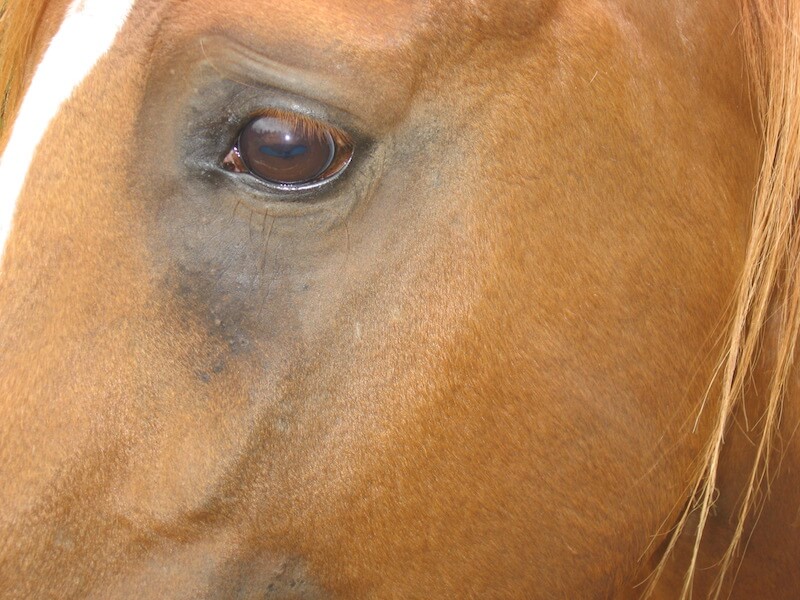Fascinating Facts about Equine Eyesight
by Don Blazer

Horses have remarkable eyes. They can, at one time or another, and sometimes in combination, have a feather in the eye, a glass eye, a pig eye, a smoky eye or a walleye. In addition they have both monocular and binocular vision. They use monocular vision to see separate things with each eye at the same time. These objects are at the side and behind. They use binocular vision to see things in front of them, concentrating both eyes on the same object (remember, a horse’s ears point where he is looking whether together or separately). The horse has vision up to 300 degrees; he doesn’t see directly in front of him at close range and he can’t see directly behind himself if his nose is straight ahead.
Large eyes, set well out to the side of the head, have always been considered a mark of quality. And while the horse should have large eyes, having them placed well out to the side may be a handicap from a learning point of view. The eyeball of most horses is actually about the same size, it is the construction of the eye socket which makes the eye look larger or smaller. The farther out the placement, the more the horse must concentrate for frontal vision, the vision which rates highest on the ability scale of learning. Placement of the eye to the side of the head is only one of the horse’s vision related limitations.
We are pretty sure horses don’t see in color; and we know the retina of the eye is somewhat flattened rather than curved, meaning objects are frequently out of focus. To bring objects into focus, the horse must often lower, tilt or raise his head. The horse’s eye does not focus well on objects that are closer than 4 feet, and when a horse’s head is high in the air he cannot see the ground in front of him—one of the reasons for appreciating a lower head carriage.
Because of a special system within his eye, the corpus negre (black body) which absorbs light rays from above, the horse cannot see clearly that which is above the level of his eye.
All the advantages and limitations of the horse’s vision affect the way he behaves, a circumstance more riders need to take into consideration. Imagine what a horse sees wherever you take him. There are cars, people and all sorts of unknown objects which have never been investigated and may certainly be dangerous. Moreover, at any time there is always something happening on each side of the horse and most of the time it is probably not in focus (even if it were, the horse may have never seen anything like it before).
To see what is going on in front of him, the horse must concentrate his full attention straight head, but how can he do that when there is so many new and interesting things to see on each side of him? While you shouldn’t blame the horse for being a bit flighty (his natural defense) most people do. Jerking, spanking or trying to force the horse to be calm simply won’t work, only understanding how he sees and applying the knowledge will help. Good horsemanship starts by knowing that with the horse “everything that meets the eye isn’t exactly what he sees.”
Now take a look at some “seeing” terminology. A feather in the eye refers to a visible blemish on the eye. The blemish may be the result of an injury or natural defect. In either case, it is considered a fault. A glass eye lacks color and may be the cause for disqualification by some breed registries. A pig eye is a small squinty eye and a horse with pig eyes is generally considered to be stubborn and hard to handle. Could it be he just doesn’t see things clearly? A pop eye is the opposite of a pig eye; it is the description given to an eye that seems to be too large and protruding from the head. A smoky eye is an eye that is cloudy in color, almost a smoke gray. A walleye is another term for an eye without color and is sometimes referred to as a China eye.
Don Blazer is the author of 7 books on horse care and training and teaches for www.horsecoursesonline.com which offers an accredited equine study degree and/or professional certifications in Horse Training, Stable Management and Riding Instruction.
Published July 2012 Issue

Don Blazer developed and taught the course The Business of Making Money With Horses for www.horsecoursesonline.com, the worldwide leader in online equine curriculum. Also the author of the syndicated columns “A Horse, of Course” and ”Making Money with Horses”, Don lost his battle with lung cancer on April 7, 2014. However, the horse community is grateful that his wisdom lives on through the wealth of books and articles he wrote over the years.

